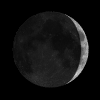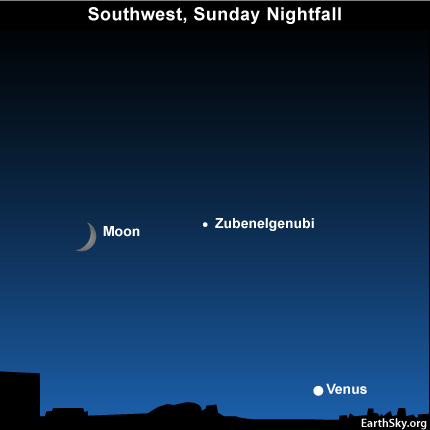Courtesy of EarthSky
A Clear Voice for Science
www.EarthSky.org [1]
 [2]
[2] [3]Our chart shows the moon, the planet Venus and the star Zubenelgenubi as they appear about one hour after sunset. The sky scene, though specifically for mid-northern latitudes in North America, will look similar at mid-northern latitudes all around the world. However, European and Asian observers will see the moon somewhat closer to Zubenelgenubi [4], the constellation Libra’s rather faint yet visible star.
[3]Our chart shows the moon, the planet Venus and the star Zubenelgenubi as they appear about one hour after sunset. The sky scene, though specifically for mid-northern latitudes in North America, will look similar at mid-northern latitudes all around the world. However, European and Asian observers will see the moon somewhat closer to Zubenelgenubi [4], the constellation Libra’s rather faint yet visible star.
Bright star in east? Might be planet Jupiter, nearly at its closest since 1951. [5]
If you have binoculars, zoom in on Zubenelgenubi. You will see this single point of light blooming into a double star. It might be a true binary – two stars revolving around a common center of mass. If so, its orbital period could be as long as 200,000 years.
 [6]Observers in the southern hemisphere see the moon and Zubenelgenubi over Venus – not to Venus’ upper left. Moreover, these objects set later after dark in the southern skies. Venus – the first of these bodies to set – stays out for only about one and one-quarter hours after sunset at our mid-northern latitudes.
[6]Observers in the southern hemisphere see the moon and Zubenelgenubi over Venus – not to Venus’ upper left. Moreover, these objects set later after dark in the southern skies. Venus – the first of these bodies to set – stays out for only about one and one-quarter hours after sunset at our mid-northern latitudes.
Through the telescope, Venus now appears as a waning crescent. Yesterday [7], we asked if the terminator – shadow line – on Venus disk represented a Venusian sunrise or sunset. Answer: sunset.
Tonight catch the moon, Venus and Libra’s double star low in the southwest at nightfall!
Written by Bruce McClure [8]
“False Dawn” This Week: Zodiacal Light Easier to See [9]
Andrew Fazekas
for National Geographic News [10]
Published September 9, 2010
Astronomy Picture of the Day from NASA/JPL [11]
CHANDRA Photo Album [12]
U.S. Naval Observator Astronomical Information cente [13]r
Universe Today [14]
StarDate Online [15]
Sky and Telescope [16]
National Geographic [17]
Space Com [18]
Amazing Space [19]
The York County Astronomical Society [20]
Scope City [21]